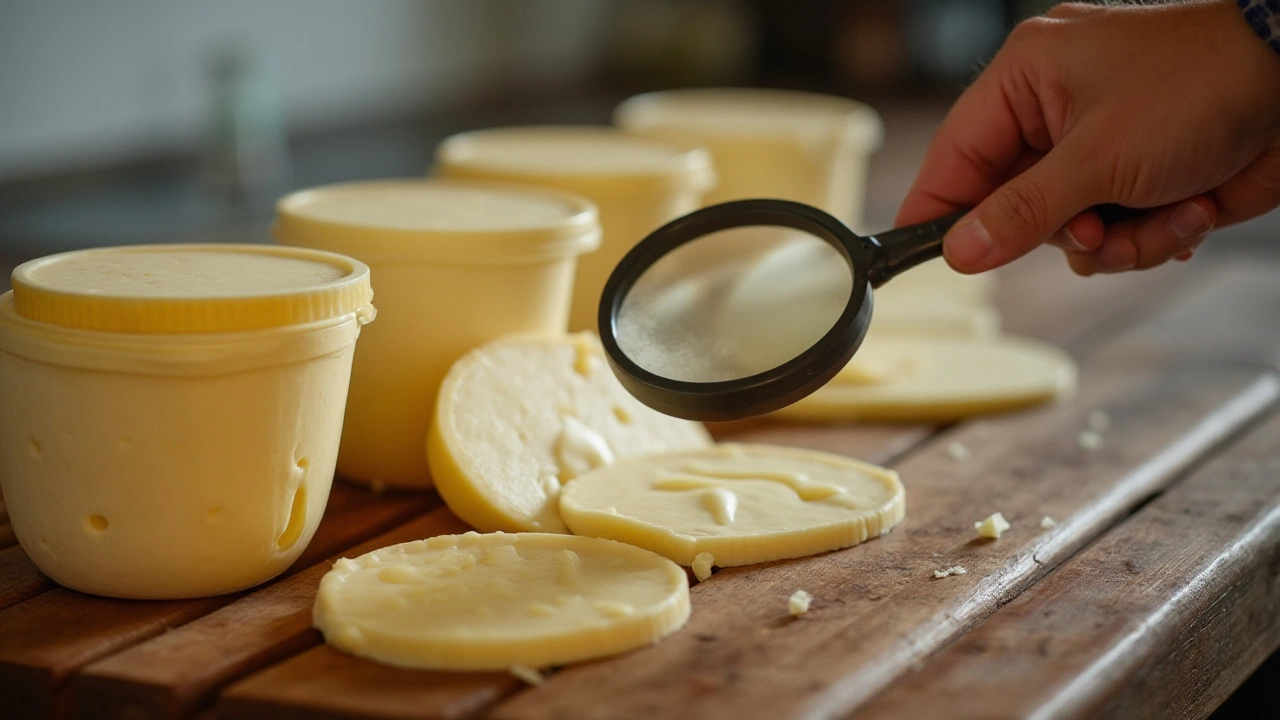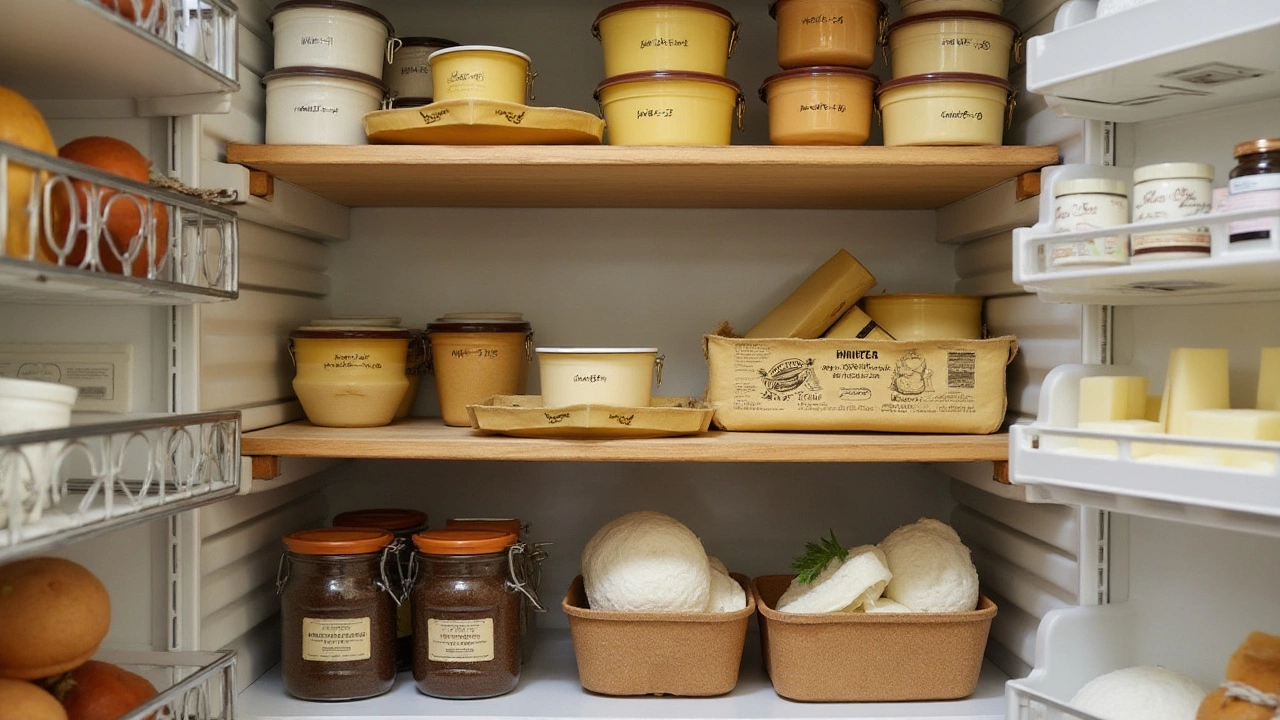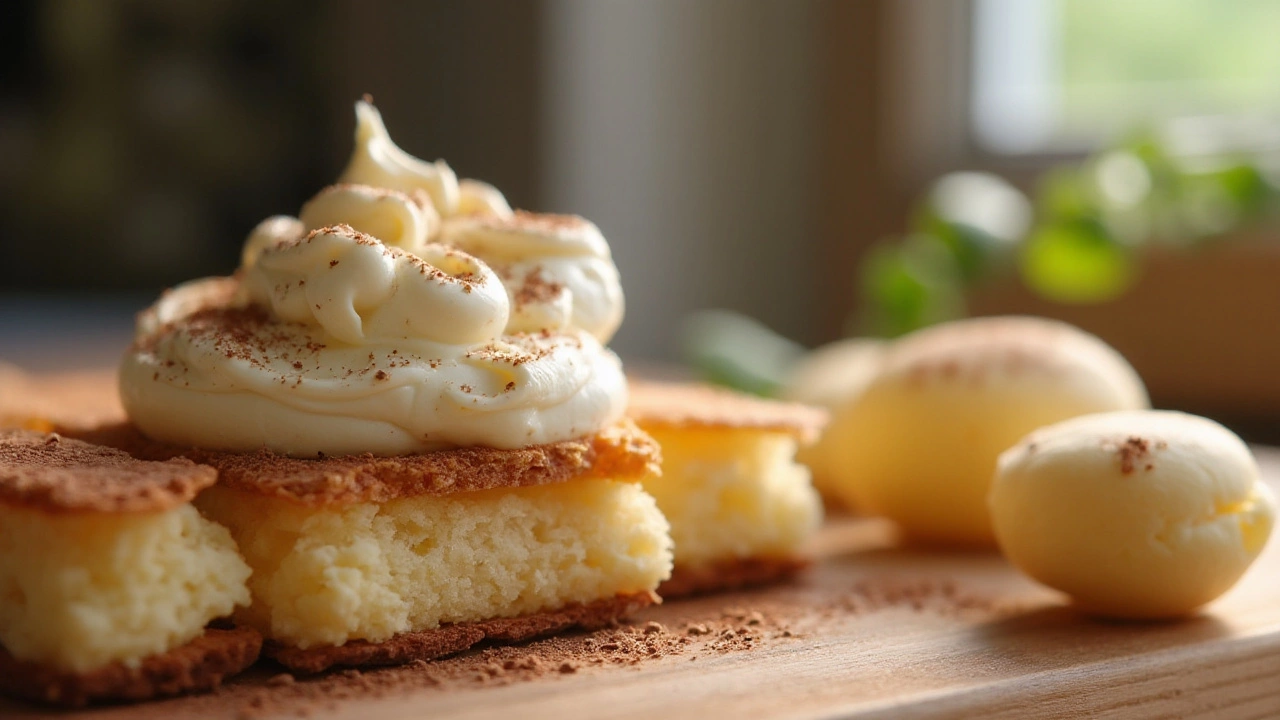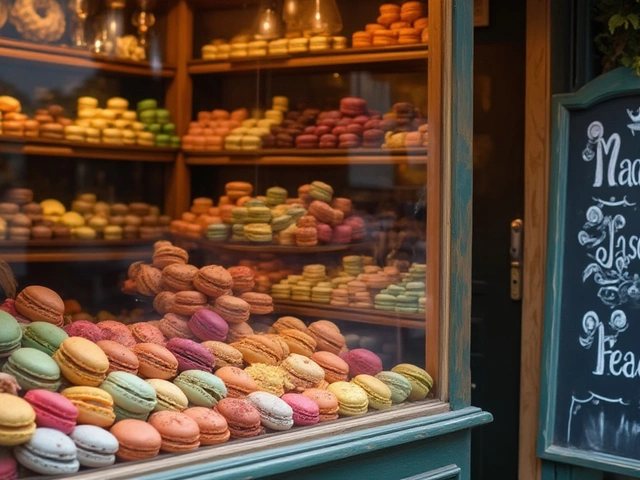Mascarpone cheese, with its velvety texture and rich flavor, is an essential ingredient in many desserts, most notably the classic tiramisu. But like any dairy product, it has a shelf life, and knowing how to detect spoilage can save your dish and your health.
In this guide, we'll explore how you can keep your mascarpone cheese fresh and delectable. Whether you're a seasoned baker or a culinary novice, these practical insights will ensure your tiramisu and other creations are always at their best.
- Understanding Mascarpone Basics
- Recognizing Signs of Spoiled Mascarpone
- The Importance of Proper Storage
- Shelf Life and Expiry Guidelines
- Alternatives to Fresh Mascarpone
- Tips for Safe Usage in Recipes
Understanding Mascarpone Basics
Diving into the creamy world of mascarpone cheese is like stepping into an Italian kitchen, where rich flavors and textures meet to create culinary masterpieces. Originating from Italy, mascarpone is a type of fresh cream cheese that boasts a soft, buttery consistency. Unlike other types of cheese, mascarpone has a higher fat content, which gives it that characteristically smooth and velvety mouthfeel that folks adore in desserts such as tiramisu. While cream cheese uses lactic acid cultures, mascarpone is crafted using citric or tartaric acid, lending to its uniquely rich and slightly sweet profile, perfectly balancing out desserts and adding luxury to everyday recipes.
History and Production
The history of mascarpone dates back to the region of Lombardy in Italy, an area known for its lush pastures and dairy excellence. Traditionally, mascarpone was made during the fall and winter months since cows' diets are much more robust and varied during these times, influencing the richness of the milk. To make mascarpone, fresh cow's milk cream is gently heated and then curdled using citric or tartaric acid. This process is delicate, needing just the right temperature control to produce its beloved texture. Once the cream thickens, it is filtered through a cheesecloth until it reaches the desired consistency. The result? A lusciously smooth cheese that's higher in fat than most, typically ranging between 60 to 75 percent fat content.
Enjoying mascarpone is not limited to sweet delights. This versatile cheese can be savored on its own, slathered on freshly baked bread, or used in savory dishes such as risottos and pasta, where it imparts a creamy depth often enhanced by herbs and spices. In Italy, this cheese might also grace the table alongside polenta, being served with honey or mustard fruits, an ensemble that embodies regional culinary artistry. According to renowned culinary expert Marcella Hazan, "Mascarpone’s sublime silkiness is a testament to its artisanal heritage, reflecting a dedication to time-honored methods of fine cheese production."
Mascarpone vs. Other Cheeses
When comparing mascarpone to other cheeses, it stands apart not only because of its fat content but for its distinctly smooth and luscious texture. Unlike ricotta cheese, which is grainier and often associated with weightier dishes, mascarpone offers a silkier and more understated taste. Cream cheese, often the American go-to for spreads and cheesecakes, can have a tartness and firmness that mascarpone lacks. And while it might be tempting to substitute with cream cheese due to availability, the two cheeses produce quite different results in desserts, particularly in tiramisu, where the creaminess of mascarpone provides a crucial balance to the coffee and cocoa flavors.
Despite being more expensive and sometimes elusive outside of specialty stores, the indulgent nature of mascarpone invites chefs and home cooks to experiment, exploring beyond just the classic tiramisu. Whether used as a decadent filling in a fruit tart or spooned atop a warm soup, mascarpone carries an elegance and tradition that elevates a simple dish into something extraordinary. Knowing its pedigree and production nuances truly enhances appreciation, fostering a deeper respect for this luxuriant cheese.
Recognizing Signs of Spoiled Mascarpone
Spotting a bad batch of mascarpone cheese before you use it in your tiramisu or any beloved recipe is crucial. The first telltale sign that mascarpone has gone south is its texture. Fresh mascarpone is gloriously smooth and creamy, spreading easily with a butter-like consistency. If the cheese starts looking grainy or curdled, that's a big red flag. This change in texture often indicates that the cheese's fats and proteins have started to separate, usually due to bacterial activity or improper storage conditions.
Color is another dead giveaway. While fresh mascarpone boasts an off-white to pale cream color, a spoiled batch may turn yellowish or develop unintended greenish or bluish tints. These colors could be a sign of mold developing, especially if you notice spotty hues that weren't there when you first unsealed the container.
Next, don’t underestimate the power of smell. Mascarpone should have a mild, sweet cream aroma. A sour or rancid smell means it's time to say goodbye to that tub and head to the store for a fresher one. Taste testers are helpful too, but no one should have to risk a bellyache to confirm spoilage. A tingy or bitter flavor is a clear indicator that it’s past its prime.
“When selecting and handling mascarpone, always trust your senses—if it looks off, smells strong, or doesn’t taste quite right, discard it,” advises Jean Stulz, renowned chef and culinary educator.
Another point to consider: Beware of expiry dates as they provide a useful guideline but aren't foolproof. An unopened container that's well within date can still spoil if mishandled or exposed to fluctuating temperatures, like suntanning on a sunny counter. Once opened, this cheese requires refrigeration under stable, cool conditions, ideally in the coldest zone of your fridge. Also, note that mascarpone doesn't like being left out for long, so swift usage post-opening is best.
Be cautious of the storage conditions in which the mascarpone has been kept both before and after opening as temperature changes can affect its lifespan. And remember, if there’s ever any doubt, it's safer to toss and replace. Your health is worth far more than a spoiled dessert.

The Importance of Proper Storage
When it comes to the luscious, creamy flavor of mascarpone cheese, ensuring it retains its freshness hinges significantly on how well it is stored. Proper storage is not merely a best practice; it's an absolute necessity to preserve the integrity of the cheese. At its core, mascarpone is a fresh Italian cheese, and because of its high moisture content, it’s far more perishable than its aged counterparts. Leaving it in less-than-ideal conditions can quickly lead to spoilage and potentially ruin your favorite tiramisu. The first step in proper storage involves maintaining a consistent refrigerator temperature, ideally at or below 4°C (39°F), which markedly slows down bacterial growth. It's crucial as this can extend the cheese's usability by several days.
In the realm of dairy products, using airtight containers is not just a matter of convenience. An airtight container can be a real game-changer, greatly minimizing exposure to air and thus helping prevent the oxidation process that can spoil your mascarpone. Not only does this method help retain the signature creamy texture of the cheese, but it also safeguards the delicate balance of flavors that make mascarpone an exceptional component in desserts. If you purchase mascarpone in a plastic tub, it’s wise to keep it in its original packaging, ensuring that the lid is firmly sealed after each use. This simple trick can be a savior in avoiding those suspicious textures and unpleasant aromas that spell disaster for sweet creations.
Another often overlooked aspect of proper storage is avoiding contamination. Always use clean utensils when scooping out mascarpone, never dipping the same utensil back into the container if it’s come into contact with other foods. In fact, a quote from Gordon Ramsay, a renowned chef, goes, "In cooking, cleanliness is next to deliciousness. Never underestimate the power of a clean spoon." Such vigilant attention ensures that extraneous substances do not introduce bacteria, accelerating spoilage. Moreover, keeping track of the use-by date and jotting down when you've opened the container can help prevent accidentally using expired cheese.
For those who find themselves not using mascarpone frequently, freezing is another option. While it's not always recommended due to potential changes in texture, if you must, ensure to double-wrap the cheese. This involves placing the original packaging inside a quality freezer bag or using a vacuum sealer. Quick freezing, followed by slow thawing in a refrigerator rather than at room temperature, helps retain as much of the original texture as possible. This can be particularly useful if you buy in bulk or have an excess amount left over from a special occasion.
To give further perspective, here’s a handy checklist of dos and don’ts for storing mascarpone:
- Do keep it refrigerated and use it before the expiration date.
- Don't leave it out of the fridge for extended periods.
- Do store it in an airtight container after opening.
- Don't cross-contaminate with unclean utensils.
- Do note the date when you've opened it to track freshness.
With these strategies, you ensure that every bite of your mascarpone cheese remains as fresh as the day you first opened it, keeping your dishes delectable and safe to eat. When treated with care and attention, mascarpone's rich character will always delight, adding that essential creamy decadence to your favorite recipes.
Shelf Life and Expiry Guidelines
Understanding the shelf life of mascarpone cheese is crucial to enjoying its rich and creamy texture without any unpleasant surprises. Typically, unopened packages of mascarpone cheese can last for several weeks, with the expiry date indicated on the label serving as a general guideline. Once opened, however, the clock starts ticking quicker. The cheese should ideally be consumed within seven to ten days to ensure the best flavor and safety. This timeline ensures that the cheese remains fresh, as any deviation can affect its taste and texture significantly. Always store opened mascarpone in an airtight container to minimize exposure to air, which accelerates spoilage. Detailed awareness of how long your cheese has been stored and maintaining the right conditions can prevent potential health risks associated with consumption of spoiled dairy.
Refrigeration is an essential factor for maintaining the freshness of mascarpone. Keep it stored at a consistent temperature between 1°C and 4°C (34°F - 39°F) to prevent the growth of undesirable bacteria that can lead to spoilage. Any variations in temperature, even minor ones, can cause the cheese to soften and encourage bacterial growth, hence always store it on the middle shelf of the fridge where temperatures are more stable. A useful tip is to avoid them keeping in the fridge door, as this area experiences the most temperature fluctuations due to constant opening and closing.
Food safety researchers suggest that if you've left your mascarpone out at room temperature for over two hours, it's best to err on the side of caution and assume it may have been compromised. The risk of contamination and growth of harmful microorganisms increases significantly beyond this timeframe. As an interesting note, a study by the USDA emphasizes the importance of temperature control in preventing the rapid increase of bacteria in dairy products, highlighting mascarpone's vulnerability to spoilage when left out for too long.
"Ensuring proper storage and adhering to these guidelines can make the difference between a delightful dessert and a potential food safety issue," advises food safety expert Dr. Mary Stapleton.
Mascarpone cheese's journey from creamy delight to unsavory disaster can be swift without proper care. Thus, it's vital to recognize even the subtlest changes in color or smell. Anything distinctly sour or off-putting can indicate spoilage. Keeping an eye on the expiry date, storing it at the right temperature, and ensuring the packaging is fully sealed will maximize its usability and your peace of mind.

Alternatives to Fresh Mascarpone
When you’re in the middle of preparing your favorite dessert like tiramisu, only to realize your mascarpone cheese might have turned, it’s important to know viable substitutes that can still give your dish the desired richness. Luckily, there are several substitutes that are not only accessible but can also replicate the creamy texture and subtle flavor of mascarpone. One popular alternative is cream cheese, which, when softened and mixed with a small amount of heavy cream, can create a similar consistency. The tangier taste of cream cheese may alter the flavor profile slightly, but many find this variation delightful.
Another substitute is a blend of ricotta and heavy cream. Ricotta on its own is grainier, so it’s important to blend it well. Adding heavy cream to ricotta can help achieve a creaminess akin to mascarpone. For a more decadent mix, consider incorporating a bit of butter for added richness. This approach works well when you're aiming to retain the creamy indulgence characteristic of high-quality mascarpone.
For those seeking a healthier or dairy-free alternative, silken tofu blended with a touch of plant-based cream or coconut cream can also mimic the texture of mascarpone. This substitute is especially appealing to vegan or lactose-intolerant individuals. Adjust the flavor by adding a pinch of salt and a bit of lemon juice to replicate the subtle tang of mascarpone.
"Substitutes are great, but always remember, the secret to a good dish lies in understanding the flavors and balancing them wisely," culinary expert Alex Guarnaschelli advises.
If you transport to an enthusiastic home cook’s kitchen, you might even find homemade mascarpone being prepared. A simple process involving heating heavy cream and lemon juice allows for a fresh, self-made mascarpone alternative. This option is time-intensive but highly rewarding, with the added advantage of control over the entire process, thus ensuring no additives or preservatives.
Each substitute has its pros and cons; hence, it’s crucial to consider the specific requirements of your recipe. Whether it is the blending capability of the ricotta, the tang of the cream cheese, or the creamy smoothness of silken tofu, each offers unique qualities to harmonize with your culinary creation. When replicating the texture of mascarpone, focusing on maintaining balance and richness goes a long way in ensuring your dish stays delicious and closest to its traditional roots.
Tips for Safe Usage in Recipes
When working with mascarpone cheese, ensuring its freshness is crucial for maintaining the quality and safety of your culinary creations. This creamy culinary gem is particularly revered in dishes like tiramisu, where its smooth texture and mild flavor form a key component. Here are some helpful suggestions to properly handle mascarpone in your kitchen. First and foremost, always inspect the packaging before purchasing. Check the expiration date, which is typically printed on the container. A general rule of thumb is to use mascarpone within a week of opening, because that's when it retains optimal freshness. As with most dairy products, it should be stored in the coldest part of your fridge. Ensure the lid is tightly sealed when stored to prevent any exposure to other fridge smells or bacterial contamination.
Once you're ready to create your dessert masterpiece, it's key to let your refrigerated mascarpone come to room temperature before mixing it into a dish. This not only eases blending but also helps achieve the right texture for your tiramisu. If you're mixing it with sugar or eggs, always use a clean, dry spoon to avoid introducing any unwanted moisture or bacteria. If in doubt about the mascarpone's condition, conduct a quick sensory evaluation. The appearance of mold or an off-putting smell are clear indicators the cheese has spoiled and shouldn't be used in any recipes, regardless of the expiration date. While making your recipes, consider portion sizes carefully. Excess mixture can spoil quickly, especially if it contains ingredients that spoil rapidly like eggs. If you're creating dishes that require heat, avoid cooking mascarpone for long periods as it can alter the texture and flavor. Dishes like pasta sauces benefit from mascarpone's creaminess when it's added towards the end of the cooking process, just to incorporate warmth without separating the curds and whey.
For those who enjoy experimenting, substitute options like cream cheese or ricotta can mimic mascarpone's texture if it’s not available. However, remember these substitutes contain different fat and moisture levels, which may slightly alter the dish's overall flavor profile. As Jane Doe, a culinary expert, suggests,
"Incorporating mascarpone into cold desserts like tiramisu allows its lush, silky consistency to shine without any interference from heat, making it the star ingredient."It’s always crucial to choose the right recipe that highlights its unique features. When choosing a substitute, ensure your flavors align with your expectations and the recipe’s demands.





